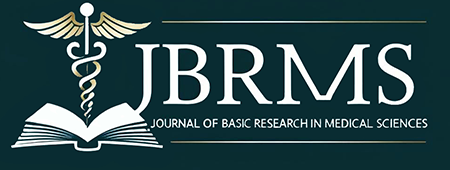Volume 8, Issue 1 (1-2021)
jbrms 2021, 8(1): 41-48 |
Back to browse issues page
Download citation:
BibTeX | RIS | EndNote | Medlars | ProCite | Reference Manager | RefWorks
Send citation to:



BibTeX | RIS | EndNote | Medlars | ProCite | Reference Manager | RefWorks
Send citation to:
Heidari M, Hosseinpourfeizi M, Seyyed Sani N, Dastmalchi N, Saeid Moradzadeh Tehrani M, Soleyman-Nejad M et al . Evaluation of the Effect of PLGA-PAA Nano-Encapsulated Hydroxytyrosol on Inhibiting the Colorectal Cancer Cell Line HT-29 and Underlying Mechanism of Action. jbrms 2021; 8 (1) :41-48
URL: http://jbrms.medilam.ac.ir/article-1-515-en.html
URL: http://jbrms.medilam.ac.ir/article-1-515-en.html
Masoud Heidari 

 , Mohammadali Hosseinpourfeizi
, Mohammadali Hosseinpourfeizi 

 , Nasrin Seyyed Sani
, Nasrin Seyyed Sani 
 , Narges Dastmalchi
, Narges Dastmalchi 

 , Mohammad Saeid Moradzadeh Tehrani
, Mohammad Saeid Moradzadeh Tehrani 
 , Morteza Soleyman-Nejad
, Morteza Soleyman-Nejad 
 , Reza Safaralizadeh
, Reza Safaralizadeh 




 , Mohammadali Hosseinpourfeizi
, Mohammadali Hosseinpourfeizi 

 , Nasrin Seyyed Sani
, Nasrin Seyyed Sani 
 , Narges Dastmalchi
, Narges Dastmalchi 

 , Mohammad Saeid Moradzadeh Tehrani
, Mohammad Saeid Moradzadeh Tehrani 
 , Morteza Soleyman-Nejad
, Morteza Soleyman-Nejad 
 , Reza Safaralizadeh
, Reza Safaralizadeh 


Department of Animal Biology, Faculty of Natural Sciences, University of Tabriz, Tabriz, Iran , safaralizadeh@tabrizu.ac.ir
Abstract: (2790 Views)
Introduction: Chemotherapy was known as a potential approach for colon cancer therapy. Polymer-based nanocarriers prolong the circulation time of chemotherapeutic drugs, therefore anti-tumor drugs can passively accumulate in the malignant tumor position through the improved permeability and retention effect. The aim of the present study was to investigate anticancer potency of biodegradable and pH-sensitive nano-encapsulated Hydroxytyrosol in HT-29 cancer cell line and the potential molecular mechanism of action of Hydroxytyrosol.
Materials and Methods: The poly lactide-co-glycolide-co-polyacrylic acid (PLGA-co-PAA) nano-encapsulated Hydroxytyrosol was synthesized, and 3-(4,5-dimethylthiazol-2-yl)-2,5-diphenyl-2H-tetrazolium bromide (MTT) assay was performed to evaluate the anti-proliferative and anti-tumor effects of both free and nano-encapsulated Hydroxytyrosol. The relative expression of colorectal cancer associated-1 (COCA1) gene was investigated by quantitative Real-Time PCR (qRT-PCR).
Results: We observed that free and nano-encapsulated Hydroxytyrosol significantly decreased the viability of HT-29 cancer cells. Moreover, the cytotoxic effect of nano-encapsulated Hydroxytyrosol on HT-29 cancer cells was significantly more than that of free Hydroxytyrosol. Also, the COLCA1 gene expression was up-regulated significantly in HT-29 cancer cells treated with either free or nano-encapsulated Hydroxytyrosol.
Conclusion: Generally, we showed that the anticancer potency of Hydroxytyrosol was significantly increased by a biodegradable and pH-sensitive nanoparticle. However, further studies on animal models seem necessary.
Materials and Methods: The poly lactide-co-glycolide-co-polyacrylic acid (PLGA-co-PAA) nano-encapsulated Hydroxytyrosol was synthesized, and 3-(4,5-dimethylthiazol-2-yl)-2,5-diphenyl-2H-tetrazolium bromide (MTT) assay was performed to evaluate the anti-proliferative and anti-tumor effects of both free and nano-encapsulated Hydroxytyrosol. The relative expression of colorectal cancer associated-1 (COCA1) gene was investigated by quantitative Real-Time PCR (qRT-PCR).
Results: We observed that free and nano-encapsulated Hydroxytyrosol significantly decreased the viability of HT-29 cancer cells. Moreover, the cytotoxic effect of nano-encapsulated Hydroxytyrosol on HT-29 cancer cells was significantly more than that of free Hydroxytyrosol. Also, the COLCA1 gene expression was up-regulated significantly in HT-29 cancer cells treated with either free or nano-encapsulated Hydroxytyrosol.
Conclusion: Generally, we showed that the anticancer potency of Hydroxytyrosol was significantly increased by a biodegradable and pH-sensitive nanoparticle. However, further studies on animal models seem necessary.
Type of Study: Research |
Subject:
Toxicology
Received: 2020/04/11 | Accepted: 2020/07/11 | Published: 2021/02/18
Received: 2020/04/11 | Accepted: 2020/07/11 | Published: 2021/02/18
Send email to the article author
| Rights and permissions | |
 |
This work is licensed under a Creative Commons Attribution-NonCommercial 4.0 International License. |


